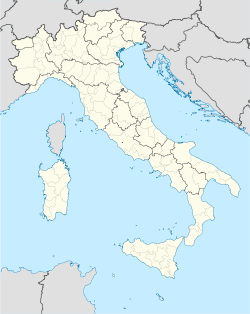- Pietrasanta
-
Piestrasanta — Comune — Città di Pietrasanta Cathedral square with the church of Sant'Agostino in the background. 
Coat of armsLocation of Piestrasanta in Italy Coordinates: 43°58′N 10°14′E / 43.967°N 10.233°E Country Italy Region Tuscany Province Lucca (LU) Frazioni Capezzano Monte, Capriglia, Strettoia (Montiscendi), Traversagna (Pollino), Vecchiuccio, Vallecchia, Solaio, Vitoio, Castello, Valdicastello, Crociale (Ponte Rosso), Africa (Pisanica), Macelli, Osterietta, Marina di Pietrasanta (Fiumetto, Tonfano, Motrone, Focette), Città Giardino (Le Pere) Government – Mayor Domenico Lombardi Area – Total 41 km2 (15.8 sq mi) Elevation 14 m (46 ft) Population (1 January 2009[1]) – Total 24,826 – Density 605.5/km2 (1,568.3/sq mi) Demonym Pietrasantini or Pietrasantesi Time zone CET (UTC+1) – Summer (DST) CEST (UTC+2) Postal code 55044, 55045 Dialing code 0584 Patron saint Sts. Blaise and Martin Saint day February 3 Website Official website Pietrasanta is a town and comune on the coast of northern Tuscany in Italy, in the province of Lucca. Pietrasanta is part of Versilia, on the last foothills of the Apuan Alps, about 32 km north of Pisa. The town is located 3 km off the coast (where the frazione of Marina di Pietrasanta is located).
The Pietrasanta Marina, with golden sand and luxorios equipments is considered one of the best beaches of Italy.
Contents
History
The town has Roman origins and part of the Roman wall still exists.
The medieval town was founded in 1255 upon the preexisting "Rocca di Sala" fortress of the Lombards by Luca Guiscardo da Pietrasanta, from whom it got its name. Pietrasanta was at its height a part of the Republic of Genoa (1316–1328). The town is first mentioned in 1331 in records of Genoa, when it became a part of the Lucca along with the river port of Motrone, and was held until 1430. At that time it passed back to Genoa until 1484, when it was annexed to the Medici held seigniory of Florence.
In 1494, Charles VIII of France took control of the town. It remained a Luccan town again until Pope Leo X, a member of the Medici family, gave Pietrasanta back to his family.
The town suffered a long period of decline during the 17th and 18th centuries, partially due to malaria. In 1841, Grand Duke Leopold II of Tuscany promoted several reconstruction projects (including the building of schools specially created to teach carving skills, and the reopening of the once famous quarries).
The town then became the capital of the Vicariato di Pietrasanta, which included the towns of Forte dei Marmi, Seravezza and Stazzema (this region became the historical heart of Versilia). The town joined the newly-unified Italian Kingdom in 1861.
Main sights
- Cathedral of St. Martin (Duomo, 13th-14th centuries).
- Church of Saint Augustine (15th century), in Romanesque style, now seat of art exhibitions. It includes some remains of 14th-15th centuries frescoes.
- The Gothic Civic Tower.
- Column and Fountain of the Marzocco (16th century).
- Palazzo Panichi Carli (16th century).
- Palazzo Moroni (16ht century), home to the local Archaeological Museum.
Culture
The area, like most of Tuscany in general, has long enjoyed the patronage of artists. Pietrasanta grew to importance during the 15th century, mainly due to its connection with marble. Michelangelo was the first sculptor to recognize the beauty of the local stone.
Today, the Colombian painter and sculptor Fernando Botero, the Dutch-born sculptor Hanneke Beaumont, the Danish sculptor Jens Flemming Sørensen as well as the Polish sculptor Igor Mitoraj and Polish F1 driver Robert Kubica have residences in the comune.
Composer, conductor and concert pianist Cesare Galeotti, best known for his opera's Anton and Dorisse, was born in Pietrasanta on 5 June 1872.
Sister cities
Pietrasanta is twinned with[2]
 Écaussinnes, Belgium
Écaussinnes, Belgium Grenzach-Wyhlen, Germany
Grenzach-Wyhlen, Germany Villeparisis, France
Villeparisis, France Zduńska Wola, Poland
Zduńska Wola, Poland Montgomery, Alabama
Montgomery, Alabama Utsunomiya, Japan
Utsunomiya, Japan
References
- ^ Data from Istat
- ^ Official website page
External links
- Official website (Italian)
- Pietrasanta Portal (Italian)
- Video Introduction to Pietrasanta (English)
- Downtown accommodation (English)
- Ask for the Pietrasanta newsletter (English issue) about Marble, Art and Tourism (English)
Tuscany · Comuni of the Province of Lucca Altopascio · Bagni di Lucca · Barga · Borgo a Mozzano · Camaiore · Camporgiano · Capannori · Careggine · Castelnuovo di Garfagnana · Castiglione di Garfagnana · Coreglia Antelminelli · Fabbriche di Vallico · Forte dei Marmi · Fosciandora · Gallicano · Giuncugnano · Lucca · Massarosa · Minucciano · Molazzana · Montecarlo · Pescaglia · Piazza al Serchio · Pietrasanta · Pieve Fosciana · Porcari · San Romano in Garfagnana · Seravezza · Sillano · Stazzema · Vagli Sotto · Vergemoli · Viareggio · Villa Basilica · Villa CollemandinaCategories:- Cities and towns in Tuscany
- Communes of the Province of Lucca
Wikimedia Foundation. 2010.



